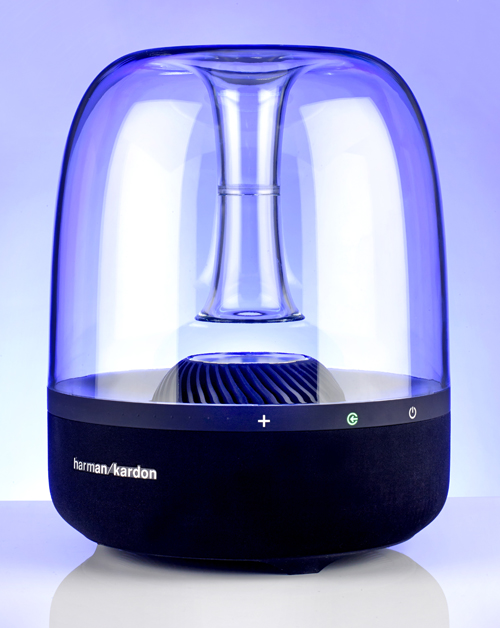What Hi-Fi? Verdict
A stunning looking speaker, but one that doesn’t have the ‘wow’ sound or usability to boot
Pros
- +
Creative design
- +
well built
- +
Tonally balanced
- +
Room-filling sound
Cons
- -
Lacks detail and dynamics of rivals
- -
Loose bass
- -
No dedicated remote
- -
App lacks features
Why you can trust What Hi-Fi?
Wireless speakers have been known for rebelling against standard box casing (have you seen the Philips Shoqbox SB7220?) and Harman-Kardon’s latest wireless speaker is definitely up there with the craftiest of creations.
At first glimpse it would be easy to mistake the Aura for a food blender, or for the comic book fans among us, a replica of Charles the Brainchild’s glass skull from The Tick.
Design
Its transparent polycarbonate, dome-shaped enclosure is certainly out there and draws inspiration from the mould of the company’s SoundSticks desktop speakers.
The speaker’s centrepiece is to be admired: a reflex port descends down into the dome and meets a round coil-like feature at the bottom of the basin. Look carefully and you’ll see this is the back end of the 11.5cm bass driver.
On the outside, a black – or white if you opt for that finish – clothed grill occupies the bottom part of the shell, enclosing six 4cm high/mid drivers that wrap around the unit. Consequently, sound is dispersed in every direction.
Its design is a work of art and the wow factor carries into its build. About the size of a basketball and weighing only 2.3kg, the Aura is more robust and lightweight than appearance suggests. Its slick, refined surfaces also make it nice to handle.
So bravo to Harman-Kardon for creating a look that is reflective of the price tag. If you’re looking for a versatile, space-saving alternative to a multi-speaker set-up that will sit just about anywhere, this snazzy speaker will do the trick.
There is no text display: instead, illuminating, colour changing LED lights and the occasional beep of recognition lead the way.
Power it on and a glowing ring at the speaker’s core prompt a few ‘oohs’ and ‘aahs’ early on.
Features
So what does this radiant bubble actually do?
It can stream music with a Bluetooth connection and track down files on your home network via DLNA or AirPlay with its built-in wi-fi. Alternatively, a wired connection can be made via its 3.5mm or optical inputs.
You will notice a USB slot around the back too, though this is only marked for service. The unit runs off the mains, so a power supply input completes the cluster of connections at the back.
A thin band featuring touch buttons around the middle of the speaker control power, volume and source selection. Peer closely or run your fingers along it and you will notice a 3.5mm output for your headphones.
It’s a tidy arrangement and controls are sensitive to press or, as with the volume, slide across. The absence of a dedicated remote control though means changing input sources is only possible on the unit itself.
There is a free ‘Harman-Kardon remote’ app for Android and iOS devices, however, which you download to play music from a home network.
The app is a hub to manage your compatible Harman-Kardon devices. The key functions are there: you can sift through a device’s music library; queue and repeat songs, or share them via email, Facebook or Twitter. There’s a bass EQ too, though nothing to adjust the treble.
It doesn’t allow you to create playlists or see file type or size, while its several-shades-of-grey interface could do with a splash of colour.
A flashier app would mirror the speaker’s image, but Harman-Kardon has opted for simplicity here. As a result, it’s remarkably straightforward to use.
Performance
We selected David Bowie’s Life On Mars from our NAS box and – thanks to its multi-directional sound and the company’s stereo-widening DPS technology – the Aura gives a big, room-filling sound. It has no problem eating up our test room space.
An initial spin through our playlist revealed a thin and bright sound. But a weekend’s run-in smoothed out these rough edges, making way for a more self-assured and balanced presentation.
Its even tones make journeying through the gritty 60s-inspired folk music from the Inside Llewyn Davis: Original Recording Soundtrack an enjoyable ride.
Now we come to the not-so-impressive side of the Aura.
Dense music recordings expose the first blot on the copybook. Lack of clarity and detail make busy compositions congested and messy.
Beats, raw, aggressive instrumentals and James Hetfield’s growl are a far cry from clear as they thrash around in Metallica’s Enter Sandman. And this is emphasised even more when turned up loud.
A note of warning on higher volumes: the Aura will make any flimsy surface it sits on shake like your dad’s hips at a disco – whether blasting out Baccara’s Yes Sir, I Can Boogie or not. A sturdy base will keep distortion caused by vibration at a minimum.
We put the Aura shoulder to shoulder with the best of the rest, including the award-winning Geneva Model S Wireless DAB+ (£330).
The Geneva unearths mounds of expression in PJ Harvey’s Rid Of Me, digging out the distorted textures of her vocals. The Aura, meanwhile, glosses over its coarseness, opting for a less transparent but smooth delivery.
And generally its lack of insight is where the Aura loses out. It takes the silhouette of a note and runs with it, fixating on the leading violin in Christopher Hogwood and Alison Bury’s Vivaldi: Violin Concerto In F, Op. 8/3, but ignoring subtler details of the orchestration. You have to really strain to pluck out the flanking cello’s presence.
Its bass is pronounced – you would expect it for its size – but lacks the weight required to stamp authority on Drake’s Hold On, We’re Going Home.
While the Geneva packs a punch with a deep-rooted bass, the Aura’s feels sloppy and detached from the close-knit midrange and treble.
However, despite its shortcomings, we ambled through our hour-long playlist just fine. Play a WAV file of Eddie Vedder’s Society over a wired connection and a few creases where clarity is concerned are ironed out too.
Verdict
Had this test been all about looks, this speaker would have bagged five stars – no problem.
A stylish showpiece for any room, it’s sure to catch a few eyes, turn a few heads and steal a few hearts.
Unfortunately for the Aura we’re not that shallow. And when sound comes into play, we’re less than inspired.
If you’re only looking for background entertainment, it will deliver. But it needs more clarity, with rivals topping the leader board within this price point doing more – and doing it better.
MORE: Best bluetooth speakers
MORE: Best wireless speakers and docks 2014
What Hi-Fi?, founded in 1976, is the world's leading independent guide to buying and owning hi-fi and home entertainment products. Our comprehensive tests help you buy the very best for your money, with our advice sections giving you step-by-step information on how to get even more from your music and movies. Everything is tested by our dedicated team of in-house reviewers in our custom-built test rooms in London, Reading and Bath. Our coveted five-star rating and Awards are recognised all over the world as the ultimate seal of approval, so you can buy with absolute confidence.


